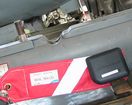Jul 27, 2006An active RFID system is being tested by the U.K.'s Royal Air Force to see if the technology can help cut costs and streamline maintenance operations for Harrier jump jets.
U.K.-based defense and security systems specialist QinetiQ has deployed an RFID system as part of an ongoing proof-of-concept RFID project for the Harrier Integrated Project Team (IPT), the group charged with supporting the RAF's fleet of Harrier aircraft with vertical takeoff and landing capability.
After more than six months of project planning, the first active RFID tags were deployed at RAF Cottesmore air base eight weeks ago. During the project, which will run until November, active RFID tags will be applied to approximately 1,200 "high value/critical" items. That comprises approximately 500 pieces of role-dependent equipment, consisting of fuel tanks, missile launchers and other items that vary depending on the flight's mission; 400 line replacement units (LRUs), which are replacement parts for the aircraft; and 300 pieces of test equipment used to determine if aircraft parts are operating properly.
Tags are being tracked across seven broad areas, including four hangers, that are split into 16 zones, each with its own by RFID interrogator (reader) so that the system can determine which zone an item is located within. These zones include each of the four aircraft maintenance and operational squadron hangars, as well as the base's entrance to record when equipment leaves the base. Approximately 37 readers have been deployed as part of the project.
The project is using RX-300 W series interrogators and TG800 and TG700 W series 433 MHz active tags, from Wavetrend Technologies, a U.K.-based provider of active RFID systems. The tags carry just a unique ID number, and information about the items to which they are attached is stored on the server. The readers are connected to each via Ethernet cables, but they use a Wi-Fi connection to relay their tag reads to a central server.
The tags are sewn inside the flags traditionally used to identify parts, and the tagged flags are then attached to the parts and test equipment. While the tags on test equipment will remain on each item throughout the project, tags on the role and LRU equipment will be removed before the items are installed on an aircraft. There is a separate zone where tags are placed when they have been removed from items. This area contains its own RFID interrogator, so that the system can verify that the tag was removed.
Even in its early stages, the trial is already demonstrating that RFID can improve efficiency within Harrier IPT's operations, according to QinetiQ.
"The proof of concept is already proving itself, as equipment can be located very quickly," says Andrew Barker, the active RFID business manager at QinetiQ. "Over one weekend, a piece of equipment was taken to be used at another site, and because the system had tracked it leaving the main gate, time wasn't wasted trying to find it on-site."
QinetiQ believes that, in addition to improving the ability to locate parts and equipment, the RFID system will enable Harrier IPT to reduce its inventory requirements through better understanding of which items are available for use and which have been deployed.
QinetiQ says it is working with Wavetrend Technologies to develop a portable interrogator that would also use Wi-Fi to communicate with the system software. The interrogator would include QinetiQ's own Q20 GPS receiver to identify its location and therefore enable the system to approximate the position of each tag it reads.


